Secure File Transfers with SCP and SFTP

When transmitting sensitive information over a network, it’s crucial to protect the data from unauthorized access and interception. SCP (Secure Copy) and SFTP (SSH File Transfer Protocol) are two widely used protocols that provide secure file transfer mechanisms.

SCP (Secure Copy)

SCP is a command-line tool that uses the SSH (Secure Shell) protocol for secure file transfer. It encrypts both the data and the user credentials, ensuring that the information remains confidential during transmission.
How SCP Works:
- Establishes an encrypted SSH connection between the source and destination systems.
- Uses the SSH protocol to authenticate the user.
- Transfers the files securely over the encrypted connection.
SFTP (SSH File Transfer Protocol)
SFTP is an extension of the SSH protocol specifically designed for file transfer operations. It offers a more interactive and user-friendly interface compared to SCP.
How SFTP Works:
- Establishes an encrypted SSH connection between the client and the SFTP server.
- Authenticates the user using SSH keys or a password.
- Allows the user to browse, create, delete, and transfer files on the remote system through a command-line interface or a graphical user interface (GUI).
Key Differences between SCP and SFTP
| Feature | SCP | SFTP |
|---|---|---|
| Interaction: | Command-line only | Command-line and GUI |
| Functionality: | Basic file transfer | Advanced file management and manipulation |
| Interactive File Browsing: | No | Yes |
| Bandwidth Management: | Limited | Supports bandwidth throttling |
Choosing the Right Protocol
The choice between SCP and SFTP depends on the specific requirements of the file transfer. For simple, one-time file transfers, SCP is a suitable option. If interactive file browsing, file manipulation, and advanced features are needed, SFTP is a better choice.
Benefits of Using SCP and SFTP
- Encryption: Ensures the privacy and confidentiality of data during transfer.
- Authentication: Protects against unauthorized access by requiring user authentication.
- Integrity: Detects and prevents data corruption or tampering during transmission.
- Convenience: Automates file transfer tasks, saving time and effort.
- Flexibility: Supports a wide range of operating systems and platforms.
Best Practices for Secure File Transfers
- Use strong encryption algorithms, such as AES-256.
- Implement two-factor authentication for added security.
- Regularly check and update software to address security vulnerabilities.
- Monitor and audit file transfer logs for suspicious activity.
- Consider using a separate network for file transfers to limit exposure to potential threats.Secure File Transfers With Scp And Sftp
Executive Summary
This article explores the benefits of secure file transfers, including the benefits of using SCP and SFTP. The text advises informing yourself by conducting independent research and weighing the pros and cons of various options before implementing a solution.
Introduction
With the proliferation of cyberattacks, it is more important than ever to understand how to send and receive files securely. This blog post will explain the process of setting up and using SCP and SFTP to transfer files between a local computer and a Linux host.
File Transfer Protocols
There are several different file transfer protocols available, each with its own set of advantages and disadvantages.
- File Transfer Protocol (FTP) is a widely used and easy-to-use protocol, but it is not secure and all details, including usernames and passwords, are sent in plaintext.
- Secure File Transfer Protocol (SFTP) is a much more secure protocol that uses SSH to encrypt all data in transit.
- SSH File Transfer Protocol (SCP) is similar to SFTP but uses a different encryption algorithm that is even more secure.
SCP
SCP is a command-line tool that allows users to securely copy files between two hosts over an SSH connection. SCP uses the same encryption algorithm as SSH, making it a very secure file transfer method.
- Port 22 is the default and only port SCP runs on.
- Syntax is scp [options] [destination].
- Source can be a file or directory on the local computer or the remote host.
- Destination can be a file or directory on the local computer or the remote host.
SFTP
SFTP is an extension of FTP that uses SSH to provide a secure file transfer protocol. While SCP is typically used for command-line file transfers, SFTP can also be used with graphical user interface (GUI) programs.
- Port 22 is the default and most common port for SFTP.
- Syntax is sftp [options] [username]@[host].
- Username is the username for the user on the remote host.
- Host is the hostname or IP address of the remote host.
Comparison
SCP and SFTP are both secure file transfer protocols, but they have some key differences:
- SCP is a command-line tool, while SFTP can be used with both command-line and GUI programs.
- SCP uses the SSH-2 encryption algorithm, while SFTP can use either the SSH-1 or SSH-2 encryption algorithm.
- SCP is typically used for transferring files between two hosts, while SFTP can also be used for browsing and managing files on a remote host.
Conclusion
SCP and SFTP are both viable options for securely transferring files. The best option for you will depend on your specific needs.
Keyword Phrase Tags
- Secure File Transfer
- SCP
- SFTP
- SSH
- File Transfer Protocol

I found this article very informative. It provides a clear and concise explanation of SFTP and SCP, and their respective security features. This article is a great resource for anyone who needs to securely transfer files over a network.
This article is missing some important information. It does not mention the differences between SFTP and SCP in terms of performance and usability. Also, it does not provide any examples of how to use SFTP and SCP.
SFTP and SCP are both secure file transfer protocols that use the SSH protocol for authentication and encryption. However, SFTP is more secure than SCP because it provides a higher level of encryption. SFTP is also more efficient than SCP, as it uses a binary protocol for data transfer.
I’m not sure I agree with the author’s assessment that SFTP is more secure than SCP. SCP uses the same SSH protocol for authentication and encryption as SFTP, so I don’t see how it could be less secure. In fact, I’ve found SCP to be more reliable than SFTP in some cases.
So, you’re telling me that the Secure File Transfer Protocol is less secure than the Secure Copy Protocol? That’s like saying that a bulletproof vest is less bulletproof than a cardboard box. It just doesn’t make sense.
Oh, great. Another article about secure file transfer protocols. Just what I needed. As if I didn’t have enough to worry about already. Thanks a lot for the help.
I bet you could use SFTP to transfer a file so securely that even the NSA couldn’t crack it. Or maybe you could use SCP to send a secret message to your friend without anyone else knowing. The possibilities are endless!
It’s important to remember that no file transfer protocol is completely secure. Even SFTP and SCP can be compromised if the attacker has access to the server or the network. Therefore, it’s important to use other security measures, such as encryption and strong passwords, to protect your data.